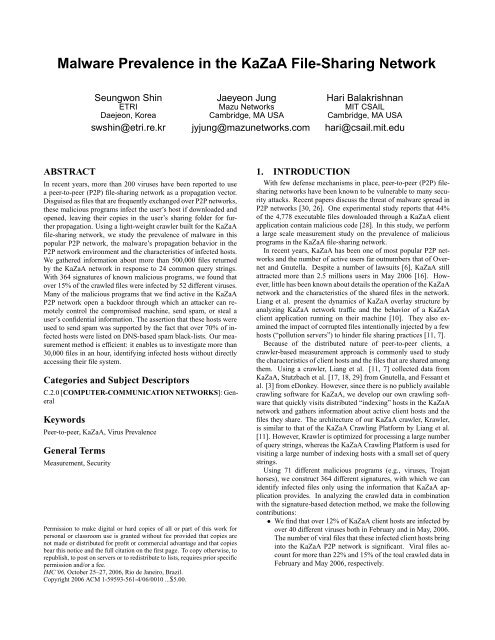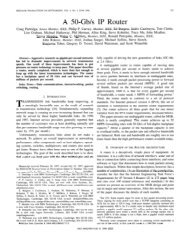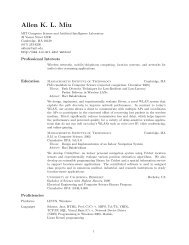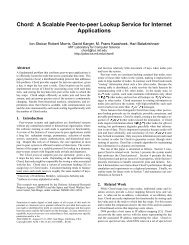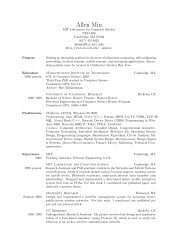Malware Prevalence in the KaZaA File-Sharing Network
Malware Prevalence in the KaZaA File-Sharing Network
Malware Prevalence in the KaZaA File-Sharing Network
Create successful ePaper yourself
Turn your PDF publications into a flip-book with our unique Google optimized e-Paper software.
<strong>Malware</strong> <strong>Prevalence</strong> <strong>in</strong> <strong>the</strong> <strong>KaZaA</strong> <strong>File</strong>-Shar<strong>in</strong>g <strong>Network</strong><br />
ABSTRACT<br />
Seungwon Sh<strong>in</strong><br />
ETRI<br />
Daejeon, Korea<br />
swsh<strong>in</strong>@etri.re.kr<br />
In recent years, more than 200 viruses have been reported to use<br />
a peer-to-peer (P2P) file-shar<strong>in</strong>g network as a propagation vector.<br />
Disguised as files that are frequently exchanged over P2P networks,<br />
<strong>the</strong>se malicious programs <strong>in</strong>fect <strong>the</strong> user’s host if downloaded and<br />
opened, leav<strong>in</strong>g <strong>the</strong>ir copies <strong>in</strong> <strong>the</strong> user’s shar<strong>in</strong>g folder for fur<strong>the</strong>r<br />
propagation. Us<strong>in</strong>g a light-weight crawler built for <strong>the</strong> <strong>KaZaA</strong><br />
file-shar<strong>in</strong>g network, we study <strong>the</strong> prevalence of malware <strong>in</strong> this<br />
popular P2P network, <strong>the</strong> malware’s propagation behavior <strong>in</strong> <strong>the</strong><br />
P2P network environment and <strong>the</strong> characteristics of <strong>in</strong>fected hosts.<br />
We ga<strong>the</strong>red <strong>in</strong>formation about more than 500,000 files returned<br />
by <strong>the</strong> <strong>KaZaA</strong> network <strong>in</strong> response to 24 common query str<strong>in</strong>gs.<br />
With 364 signatures of known malicious programs, we found that<br />
over 15% of <strong>the</strong> crawled files were <strong>in</strong>fected by 52 different viruses.<br />
Many of <strong>the</strong> malicious programs that we f<strong>in</strong>d active <strong>in</strong> <strong>the</strong> <strong>KaZaA</strong><br />
P2P network open a backdoor through which an attacker can remotely<br />
control <strong>the</strong> compromised mach<strong>in</strong>e, send spam, or steal a<br />
user’s confidential <strong>in</strong>formation. The assertion that <strong>the</strong>se hosts were<br />
used to send spam was supported by <strong>the</strong> fact that over 70% of <strong>in</strong>fected<br />
hosts were listed on DNS-based spam black-lists. Our measurement<br />
method is efficient: it enables us to <strong>in</strong>vestigate more than<br />
30,000 files <strong>in</strong> an hour, identify<strong>in</strong>g <strong>in</strong>fected hosts without directly<br />
access<strong>in</strong>g <strong>the</strong>ir file system.<br />
Categories and Subject Descriptors<br />
C.2.0 [COMPUTER-COMMUNICATION NETWORKS]: General<br />
Keywords<br />
Peer-to-peer, <strong>KaZaA</strong>, Virus <strong>Prevalence</strong><br />
General Terms<br />
Measurement, Security<br />
Permission to make digital or hard copies of all or part of this work for<br />
personal or classroom use is granted without fee provided that copies are<br />
not made or distributed for profit or commercial advantage and that copies<br />
bear this notice and <strong>the</strong> full citation on <strong>the</strong> first page. To copy o<strong>the</strong>rwise, to<br />
republish, to post on servers or to redistribute to lists, requires prior specific<br />
permission and/or a fee.<br />
IMC’06, October 25–27, 2006, Rio de Janeiro, Brazil.<br />
Copyright 2006 ACM 1-59593-561-4/06/0010 ...$5.00.<br />
Jaeyeon Jung<br />
Mazu <strong>Network</strong>s<br />
Cambridge, MA USA<br />
jyjung@mazunetworks.com<br />
Hari Balakrishnan<br />
MIT CSAIL<br />
Cambridge, MA USA<br />
hari@csail.mit.edu<br />
1. INTRODUCTION<br />
With few defense mechanisms <strong>in</strong> place, peer-to-peer (P2P) fileshar<strong>in</strong>g<br />
networks have been known to be vulnerable to many security<br />
attacks. Recent papers discuss <strong>the</strong> threat of malware spread <strong>in</strong><br />
P2P networks [30, 26]. One experimental study reports that 44%<br />
of <strong>the</strong> 4,778 executable files downloaded through a <strong>KaZaA</strong> client<br />
application conta<strong>in</strong> malicious code [28]. In this study, we perform<br />
a large scale measurement study on <strong>the</strong> prevalence of malicious<br />
programs <strong>in</strong> <strong>the</strong> <strong>KaZaA</strong> file-shar<strong>in</strong>g network.<br />
In recent years, <strong>KaZaA</strong> has been one of most popular P2P networks<br />
and <strong>the</strong> number of active users far outnumbers that of Overnet<br />
and Gnutella. Despite a number of lawsuits [6], <strong>KaZaA</strong> still<br />
attracted more than 2.5 millions users <strong>in</strong> May 2006 [16]. However,<br />
little has been known about details <strong>the</strong> operation of <strong>the</strong> <strong>KaZaA</strong><br />
network and <strong>the</strong> characteristics of <strong>the</strong> shared files <strong>in</strong> <strong>the</strong> network.<br />
Liang et al. present <strong>the</strong> dynamics of <strong>KaZaA</strong> overlay structure by<br />
analyz<strong>in</strong>g <strong>KaZaA</strong> network traffic and <strong>the</strong> behavior of a <strong>KaZaA</strong><br />
client application runn<strong>in</strong>g on <strong>the</strong>ir mach<strong>in</strong>e [10]. They also exam<strong>in</strong>ed<br />
<strong>the</strong> impact of corrupted files <strong>in</strong>tentionally <strong>in</strong>jected by a few<br />
hosts (“pollution servers”) to h<strong>in</strong>der file shar<strong>in</strong>g practices [11, 7].<br />
Because of <strong>the</strong> distributed nature of peer-to-peer clients, a<br />
crawler-based measurement approach is commonly used to study<br />
<strong>the</strong> characteristics of client hosts and <strong>the</strong> files that are shared among<br />
<strong>the</strong>m. Us<strong>in</strong>g a crawler, Liang et al. [11, 7] collected data from<br />
<strong>KaZaA</strong>, Stutzbach et al. [17, 18, 29] from Gnutella, and Fessant et<br />
al. [3] from eDonkey. However, s<strong>in</strong>ce <strong>the</strong>re is no publicly available<br />
crawl<strong>in</strong>g software for <strong>KaZaA</strong>, we develop our own crawl<strong>in</strong>g software<br />
that quickly visits distributed “<strong>in</strong>dex<strong>in</strong>g” hosts <strong>in</strong> <strong>the</strong> <strong>KaZaA</strong><br />
network and ga<strong>the</strong>rs <strong>in</strong>formation about active client hosts and <strong>the</strong><br />
files <strong>the</strong>y share. The architecture of our <strong>KaZaA</strong> crawler, Krawler,<br />
is similar to that of <strong>the</strong> <strong>KaZaA</strong> Crawl<strong>in</strong>g Platform by Liang et al.<br />
[11]. However, Krawler is optimized for process<strong>in</strong>g a large number<br />
of query str<strong>in</strong>gs, whereas <strong>the</strong> <strong>KaZaA</strong> Crawl<strong>in</strong>g Platform is used for<br />
visit<strong>in</strong>g a large number of <strong>in</strong>dex<strong>in</strong>g hosts with a small set of query<br />
str<strong>in</strong>gs.<br />
Us<strong>in</strong>g 71 different malicious programs (e.g., viruses, Trojan<br />
horses), we construct 364 different signatures, with which we can<br />
identify <strong>in</strong>fected files only us<strong>in</strong>g <strong>the</strong> <strong>in</strong>formation that <strong>KaZaA</strong> application<br />
provides. In analyz<strong>in</strong>g <strong>the</strong> crawled data <strong>in</strong> comb<strong>in</strong>ation<br />
with <strong>the</strong> signature-based detection method, we make <strong>the</strong> follow<strong>in</strong>g<br />
contributions:<br />
• We f<strong>in</strong>d that over 12% of <strong>KaZaA</strong> client hosts are <strong>in</strong>fected by<br />
over 40 different viruses both <strong>in</strong> February and <strong>in</strong> May, 2006.<br />
The number of viral files that <strong>the</strong>se <strong>in</strong>fected client hosts br<strong>in</strong>g<br />
<strong>in</strong>to <strong>the</strong> <strong>KaZaA</strong> P2P network is significant. Viral files account<br />
for more than 22% and 15% of <strong>the</strong> toal crawled data <strong>in</strong><br />
February and May 2006, respectively.
• We f<strong>in</strong>d that prevail<strong>in</strong>g viruses <strong>in</strong> a P2P network exhibit two<br />
characteristics: (1) a virus multiplies itself <strong>in</strong>to many copies<br />
with different names correspond<strong>in</strong>g to popular executable<br />
files. As a result, certa<strong>in</strong> query str<strong>in</strong>gs such as “ICQ” and<br />
“Trillian” elicit more <strong>in</strong>fected files than legitimate ones <strong>in</strong><br />
<strong>the</strong> <strong>KaZaA</strong> P2P file-shar<strong>in</strong>g network. (2) a virus generates<br />
many b<strong>in</strong>ary variants to avoid detection. We f<strong>in</strong>d that both<br />
factors appear necessary for wide spread<strong>in</strong>g.<br />
• We observe that 4.8% of <strong>in</strong>fected client hosts seen <strong>in</strong> February<br />
returned still <strong>in</strong>fected <strong>in</strong> May 2006. Moreover, 70% of<br />
<strong>in</strong>fected client hosts are listed <strong>in</strong> one or more of six DNSbased<br />
blacklists that we tested. We believe that this is a<br />
strong <strong>in</strong>dicator that <strong>the</strong>se <strong>in</strong>fected client hosts are used for<br />
relay<strong>in</strong>g spam email. More importantly, some client hosts<br />
are <strong>in</strong>fected with viruses that steal a user’s confidential <strong>in</strong>formation<br />
(Darby) and turn <strong>the</strong> victim mach<strong>in</strong>e <strong>in</strong>to a bot<br />
(IRCBot).<br />
The paper is organized as follows: §2 presents an overview of<br />
<strong>KaZaA</strong>, our crawl<strong>in</strong>g software and <strong>the</strong> malware propagation <strong>in</strong> <strong>the</strong><br />
<strong>KaZaA</strong> file-shar<strong>in</strong>g network. §3 presents our data collection methods.<br />
§4 analyzes two datasets collected <strong>in</strong> February and May, 2006.<br />
§5 summarizes <strong>the</strong> paper with a discussion of future work.<br />
2. BACKGROUND<br />
The <strong>KaZaA</strong> network uses <strong>the</strong> proprietary FastTrack protocol [25]<br />
whose technical details are not publicly available. As such, this<br />
overview comes from <strong>the</strong> exam<strong>in</strong>ation of related documents as well<br />
as our experience <strong>in</strong> reverse eng<strong>in</strong>eer<strong>in</strong>g its operation 1 and analyz<strong>in</strong>g<br />
<strong>the</strong> giFT source code [5], giFT is an open source project that attempts<br />
to support multiple peer-to-peer networks <strong>in</strong>clud<strong>in</strong>g <strong>KaZaA</strong>.<br />
We <strong>the</strong>n describe our crawl<strong>in</strong>g software that quickly visits “<strong>in</strong>dex<strong>in</strong>g”<br />
hosts <strong>in</strong> <strong>the</strong> <strong>KaZaA</strong> network and collects <strong>in</strong>formation about<br />
files that <strong>KaZaA</strong> hosts offer to share.<br />
2.1 A Basic <strong>KaZaA</strong> Operation<br />
When a user runs a <strong>KaZaA</strong> client application, <strong>the</strong> client establishes<br />
a connection with an “<strong>in</strong>dex<strong>in</strong>g” hosts, called supernodes [9].<br />
The client has a hard-coded list of possible supernodes. These supernodes<br />
form an overlay network with o<strong>the</strong>r supernodes and propagate<br />
queries received from <strong>the</strong>ir client hosts. Any client host may<br />
server as a supernode if it is accessible from <strong>the</strong> Internet (i.e., not<br />
beh<strong>in</strong>d a firewall or a NAT box) and is connected with a fast enough<br />
l<strong>in</strong>k [10, 9].<br />
When a client connects to a supernode, it sends two types of<br />
<strong>in</strong>formation to <strong>the</strong> supernode [10]. The first is <strong>the</strong> list of files that<br />
<strong>the</strong> peer<strong>in</strong>g client host has <strong>in</strong> <strong>the</strong> shar<strong>in</strong>g folder 2 [4]. A supernode<br />
creates and updates a search <strong>in</strong>dex us<strong>in</strong>g <strong>the</strong> <strong>in</strong>formation received<br />
from client hosts. Second, <strong>the</strong> client <strong>in</strong>forms <strong>the</strong> peer<strong>in</strong>g supernode<br />
of <strong>the</strong> host’s <strong>in</strong>formation, such as a client nickname, a (download)<br />
port number, and an IP address at which o<strong>the</strong>r clients can request a<br />
file download.<br />
A user can locate a file by issu<strong>in</strong>g a query that conta<strong>in</strong> a substr<strong>in</strong>g<br />
of <strong>the</strong> name of <strong>the</strong> file of <strong>in</strong>terest. Each query is sent to<br />
a directly connected supernode, which is called a parent supernode<br />
[10]. Figure 1 illustrates an example. A user who is look<strong>in</strong>g<br />
for an ICQ chatt<strong>in</strong>g client sends a query “ICQ” to <strong>the</strong> parent supernode.<br />
If <strong>the</strong> parent supernode is unable to f<strong>in</strong>d a match for <strong>the</strong> query,<br />
1 We ran various <strong>KaZaA</strong> clients, such as <strong>KaZaA</strong> [8], Poisoned [14],<br />
and <strong>KaZaA</strong> Lite [27], and analyzed packets generated from <strong>the</strong>se<br />
clients us<strong>in</strong>g E<strong>the</strong>real [1].<br />
2 A <strong>KaZaA</strong> client also scans <strong>the</strong> shar<strong>in</strong>g folders every 6 m<strong>in</strong>utes to<br />
check for added or deleted files [21].<br />
it forwards <strong>the</strong> query to o<strong>the</strong>r peer<strong>in</strong>g supernodes and <strong>the</strong> search<br />
cont<strong>in</strong>ues until <strong>the</strong> TTL reaches zero [12]. If <strong>the</strong> parent supernode<br />
receives an answer from a peer, it forwards <strong>the</strong> answer back to <strong>the</strong><br />
orig<strong>in</strong>al client. Typically, an answer is a list of <strong>the</strong> IP addresses<br />
and source ports of <strong>the</strong> hosts offer<strong>in</strong>g a match<strong>in</strong>g file, as well as <strong>the</strong><br />
<strong>in</strong>formation about <strong>the</strong> files <strong>the</strong>mselves. F<strong>in</strong>ally, <strong>the</strong> client directly<br />
connects to one of <strong>the</strong> hosts listed <strong>in</strong> <strong>the</strong> answer and downloads <strong>the</strong><br />
“ICQ.exe” file. This signal<strong>in</strong>g traffic between a client and a parent<br />
supernode is encrypted with a key that is exchanged <strong>in</strong> <strong>the</strong> beg<strong>in</strong>n<strong>in</strong>g<br />
of a session.<br />
client<br />
client<br />
client<br />
SN<br />
1 4<br />
client<br />
client<br />
Want to get “ICQ.exe”<br />
2<br />
client<br />
SN<br />
2<br />
5<br />
6<br />
2<br />
3<br />
SN<br />
SN<br />
client<br />
client<br />
client<br />
client<br />
Have “ICQ.exe”<br />
client<br />
1. client sends “ICQ” query to its parent SN<br />
2. If parent SN can not f<strong>in</strong>d file, <strong>the</strong>n forward query to connected SNs<br />
3. SN that knows client which has “ICQ.exe” answers to query<br />
4. Parent SN relays answer to <strong>the</strong> client<br />
5. Connect to <strong>the</strong> client which has “ICQ.exe”<br />
6. Download “ICQ.exe”<br />
Figure 1: Example of a <strong>KaZaA</strong> search sequence<br />
2.2 Krawler: A <strong>KaZaA</strong> Crawler<br />
This section describes <strong>the</strong> operation of our <strong>KaZaA</strong> crawl<strong>in</strong>g software,<br />
Krawler, that queries tens of thousands of active supernodes<br />
<strong>in</strong> <strong>the</strong> <strong>KaZaA</strong> network. The Krawler has two ma<strong>in</strong> components;<br />
The dispatcher ma<strong>in</strong>ta<strong>in</strong>s a list of supernodes. The fetcher<br />
communicates with <strong>the</strong> dispatcher, updates a set of supernodes to<br />
crawl, sends query str<strong>in</strong>gs to <strong>in</strong>dividual supernodes and processes<br />
responses as follows:<br />
• Krawler starts with a set of <strong>the</strong> IP addresses of 200 known<br />
supernodes <strong>in</strong> <strong>the</strong> <strong>KaZaA</strong> network and a set of query str<strong>in</strong>gs<br />
associated with <strong>the</strong> files that we seek.<br />
• Krawler attempts to make a TCP connection to each supernode<br />
<strong>in</strong> <strong>the</strong> list. If it fails to establish a TCP connection, <strong>the</strong>n<br />
it waits until <strong>the</strong> next round to get a new IP address. If it succeeds,<br />
it exchanges handshake messages with <strong>the</strong> supernode.<br />
• Krawler receives from <strong>the</strong> supernode a supernode refresh list,<br />
consist<strong>in</strong>g of up to 200 super node IP addresses. This list is<br />
stored <strong>in</strong> <strong>the</strong> dispatcher.<br />
• A fetcher sends out a set of query str<strong>in</strong>gs to each supernode<br />
and waits for responses. A response <strong>in</strong>cludes <strong>the</strong> metadata<br />
and content hash for <strong>the</strong> files that match <strong>the</strong> query str<strong>in</strong>g and<br />
<strong>the</strong> peer hosts’ IP address and download port number. If <strong>the</strong>re<br />
is no response from a particular supernode for 60 seconds,<br />
<strong>the</strong> fetcher drops <strong>the</strong> correspond<strong>in</strong>g query session. 3 All <strong>the</strong>se<br />
responses are logged for fur<strong>the</strong>r analysis.<br />
2.3 Virus Propagation <strong>in</strong> P2P <strong>Network</strong>s<br />
3 We polled a set of 100 randomly selected supernodes at every 5<br />
seconds for <strong>the</strong>ir availability. 100% of supernodes that did not respond<br />
for <strong>the</strong> first 30 seconds never responded for <strong>the</strong> entire poll<strong>in</strong>g<br />
duration.
Over <strong>the</strong> past few years, more than 200 viruses and worms have<br />
been reported to employ a peer-to-peer network as one of <strong>the</strong>ir<br />
spread<strong>in</strong>g platforms [2]. Unlike self-propagat<strong>in</strong>g network worms<br />
such as Code Red [19] and Slammer [20], most malicious programs<br />
<strong>in</strong> a P2P file-shar<strong>in</strong>g network do not send <strong>the</strong>ir copies <strong>in</strong> <strong>the</strong><br />
network by <strong>the</strong>mselves. Instead, <strong>the</strong>se viruses 4 propagate to o<strong>the</strong>r<br />
client hosts as <strong>the</strong>se clients engage <strong>in</strong> file exchanges.<br />
One characteristic of P2P viruses is that <strong>the</strong>y tend to generate<br />
a large number of viral files <strong>in</strong> <strong>the</strong> user’s shar<strong>in</strong>g folder upon <strong>in</strong>fection.<br />
Each viral file has a different filename that is likely to be<br />
popular and thus have a high chance of gett<strong>in</strong>g downloaded by o<strong>the</strong>r<br />
clients. Examples of <strong>the</strong> filenames often chosen by P2P viruses <strong>in</strong>clude<br />
“Adobe Photoshop 10 full.exe”, “W<strong>in</strong>Zip 8.1.exe”, and “ICQ<br />
Lite (new).exe”, all of which may appear legitimate to an unwary<br />
user.<br />
3. DATA COLLECTION<br />
We used three mach<strong>in</strong>es to run Krawler: one mach<strong>in</strong>e (2.1 GHz<br />
dual-core CPU and 1 GByte RAM) was dedicated for a fetcher.<br />
The o<strong>the</strong>r two mach<strong>in</strong>es (2.1 GHz CPU and 1.5 GBbyte RAM and<br />
1.42 GHz CPU and 1 GByte RAM) ran 20 and 10 fetchers, respectively.<br />
5 Although us<strong>in</strong>g more fetchers could speed up crawl<strong>in</strong>g, <strong>the</strong><br />
CPU and bandwidth constra<strong>in</strong>ts kept us from runn<strong>in</strong>g more than 30<br />
fetchers at a time. With <strong>the</strong> above configuration, Krawler was capable<br />
of <strong>in</strong>vestigat<strong>in</strong>g more than 60,000 files <strong>in</strong> an hour on average. In<br />
this section, we describe two measurement methods that enable us<br />
to (1) collect a large number of popular executable files distributed<br />
<strong>in</strong> <strong>the</strong> <strong>KaZaA</strong> network and (2) identify malicious programs <strong>in</strong> <strong>the</strong><br />
set of collected files.<br />
3.1 Query Str<strong>in</strong>gs<br />
Ideally, an extensive analysis would be possible if we could<br />
look up <strong>the</strong> complete <strong>in</strong>formation about files stored <strong>in</strong> each client’s<br />
<strong>KaZaA</strong> shar<strong>in</strong>g folder. However, to our knowledge, <strong>the</strong>re is no way<br />
to extract such <strong>in</strong>formation from a supernode 6 . When queried, a<br />
supernode returns only <strong>the</strong> <strong>in</strong>formation about files whose name (or<br />
metadata <strong>in</strong>formation) conta<strong>in</strong>s <strong>the</strong> query str<strong>in</strong>g. We observe that<br />
this query process often takes long (several seconds and longer)<br />
when more than 10 query str<strong>in</strong>gs are sent at once. As a result,<br />
many studies rely on a small set of files that match a particular set<br />
of query str<strong>in</strong>gs [11, 7].<br />
As discussed <strong>in</strong> §2.3, many viruses propagate <strong>in</strong> a P2P network<br />
by trick<strong>in</strong>g users <strong>in</strong>to download<strong>in</strong>g an <strong>in</strong>fected file and execut<strong>in</strong>g<br />
it. To <strong>in</strong>crease <strong>the</strong> chances of be<strong>in</strong>g queried, some viruses generate<br />
multiple copies of a viral program, giv<strong>in</strong>g each copy a different<br />
name (e.g., ICQ Lite .exe, ICQ Pro 2003b.exe, MSN Messenger<br />
5.2.exe), and plac<strong>in</strong>g <strong>the</strong>m <strong>in</strong> <strong>the</strong> user’s shar<strong>in</strong>g folder. Therefore,<br />
<strong>in</strong> this study, we <strong>in</strong>vestigate only .exe files and not .mp3 and<br />
o<strong>the</strong>r media files that are rarely exploited by known viruses.<br />
Table 1 shows a set of 24 keywords that we compiled from <strong>the</strong><br />
filenames of <strong>the</strong> 30 most popular files listed at www.download.com.<br />
The Web site offers reviews and free downloads of shareware and<br />
freeware and attracts a large number of users: a popular file sometimes<br />
exceeds a million downloads per week. The files that were<br />
listed <strong>in</strong> February 23, 2006, <strong>in</strong>clude spyware and adware detection<br />
software (e.g., Spyware Doctor) , W<strong>in</strong>dows utilities (e.g., W<strong>in</strong>Zip),<br />
4 We use <strong>the</strong> term, “virus”, as opposed to “worm”, to refer to a<br />
malicious program spread<strong>in</strong>g <strong>in</strong> a P2P network s<strong>in</strong>ce it requires<br />
human <strong>in</strong>tervention.<br />
5 In crawl<strong>in</strong>g <strong>in</strong> February, 2006, we used only one mach<strong>in</strong>e for 20<br />
fetchers, but we add ano<strong>the</strong>r mach<strong>in</strong>e later.<br />
6 Recall that each client periodically uploads <strong>the</strong> <strong>in</strong>formation about<br />
<strong>the</strong> files <strong>in</strong> <strong>the</strong> shar<strong>in</strong>g folder to <strong>the</strong> parent supernode.<br />
Ad, Spyware, LimeWire, ICQ, Registry, SpyBot, W<strong>in</strong>Zip, Morpheus,<br />
All, iMesh, IrfanView, W<strong>in</strong>Rar, DivX, BitComet, RealPlayer,<br />
PC, Adobe, Trillian, Camfrog, SmartFTP, Nero, MSN, Quick,<br />
Knight<br />
Table 1: Query str<strong>in</strong>gs used for data collection<br />
and P2P clients (e.g., Morpheus and BitComet). S<strong>in</strong>ce <strong>the</strong>re are no<br />
statistics available about file popularity <strong>in</strong> <strong>the</strong> <strong>KaZaA</strong> network, we<br />
use <strong>the</strong>se files as proxies for popular files.<br />
3.2 Virus Signatures<br />
We compiled a list of malicious programs that use P2P a propagation<br />
vector from many security vendor Web sites (F-secure,<br />
McAfee, Sophos). S<strong>in</strong>ce 2002, more than 200 such programs have<br />
been that were identified by those vendors [2, 23]. Among <strong>the</strong>se,<br />
we have <strong>the</strong> content hashes of 71 dist<strong>in</strong>ct malicious programs. 7<br />
We used <strong>the</strong> Sig2Dat [24] tool to get <strong>the</strong> content hash of each<br />
malicious program. The <strong>KaZaA</strong> content hash is 20 bytes <strong>in</strong> size:<br />
<strong>the</strong> first 16 bytes are <strong>the</strong> MD5 [15] of <strong>the</strong> first 300 Kbyte of <strong>the</strong> file.<br />
The last 4 bytes are <strong>the</strong> value of <strong>the</strong> custom made hash function of<br />
<strong>the</strong> length of <strong>the</strong> file. In our study, only <strong>the</strong> first 16 bytes are used<br />
for identify<strong>in</strong>g a known virus because many viruses change <strong>the</strong>ir<br />
size by append<strong>in</strong>g an arbitrary number of bytes. Table 2 shows a<br />
break-down of <strong>the</strong>se malicious programs by <strong>the</strong> propagation vector.<br />
Propagation Virus List<br />
P2P only Apsiv, Darker, Doep, Duload, HLLP.Hantaner, Logpole,<br />
PMX, SdDrop and variants (2), Sndc, Steph, Tanked and<br />
variants (4), Theug, Kwbot and variant, Archar.a, Bare.a,<br />
Benjam<strong>in</strong>.a, Wif, Gotorm, Harex.a, Harex.b, Harex.c,<br />
Kazmor.a, Lolol.a, Spear.a, Parite, Togod<br />
P2P + email Bagle variants (9), Darby, K<strong>in</strong>dal, Mapson-A, Ronoper<br />
P2P + mes- Bropia, SdBot, Supova and variants (4)<br />
senger<br />
P2P + back- SpyBot and variant<br />
door<br />
P2P + email Swen<br />
+ IRC<br />
Mail only Bagle, MyDoom, NetSky, Yosenio, Stator<br />
Etc IRCBot and variant (IRC), Tenga (RPC), Hidrag,<br />
HLLP.19920, Agent.Gen, Cryptexe, Delf and variant,<br />
Dropper (Human)<br />
Table 2: <strong>Malware</strong> breakdown by <strong>the</strong> propagation vector<br />
4. RESULTS<br />
This section presents <strong>the</strong> analysis results of two datasets,<br />
feb-06 and may-06, each of which conta<strong>in</strong>s crawl<strong>in</strong>g logs for<br />
three days <strong>in</strong> February and May 2006, respectively. 8 Table 3 summarizes<br />
each dataset <strong>in</strong> terms of <strong>the</strong> number of responses that match<br />
<strong>the</strong> query str<strong>in</strong>gs, <strong>the</strong> number of unique supernodes <strong>the</strong>se responses<br />
came from, and <strong>the</strong> number of unique <strong>KaZaA</strong> client hosts that responses<br />
are associated with.<br />
There can be duplicate responses <strong>in</strong>cluded <strong>in</strong> <strong>the</strong> dataset because<br />
(1) Krawler may have contacted <strong>the</strong> same supernode multiple times<br />
7 Actually, we have content hashes of 364 malicious programs, but<br />
71 programs are totally different types of viruses and rema<strong>in</strong><strong>in</strong>g<br />
293 programs are variants of <strong>the</strong>m.<br />
8 We have more datasets that are collected <strong>in</strong> April and o<strong>the</strong>r dates<br />
<strong>in</strong> May 2006, but do not present <strong>the</strong>ir results here as <strong>in</strong> general <strong>the</strong>y<br />
agree with <strong>the</strong> results presented <strong>in</strong> this section.
feb-06 may-06<br />
date February 23, 2006 May 4, 2006<br />
responses 654,254 532,610<br />
supernodes 10,267 15,522<br />
client hosts 19,919 28,601<br />
Table 3: Summary of <strong>the</strong> datasets: both datasets used <strong>the</strong> set of<br />
query str<strong>in</strong>gs <strong>in</strong> Table 1 for crawl<strong>in</strong>g. Krawler issues 24 queries<br />
to each supernode (<strong>in</strong> series) and ga<strong>the</strong>rs responses that may<br />
come from any peer<strong>in</strong>g supernodes. One query may generate<br />
multiple responses from a given supernode.<br />
dur<strong>in</strong>g <strong>the</strong> crawl<strong>in</strong>g 9 and (2) <strong>the</strong> way a query is propagated among<br />
peer<strong>in</strong>g supernodes (see §2.1) makes it possible that Krawler receives<br />
<strong>the</strong> same response multiple times. However, we note that<br />
174,971 (32.9%) responses from may-06 (15.3% from feb-06)<br />
correspond to unique content hashes, suggest<strong>in</strong>g that our crawl<strong>in</strong>g<br />
covered a large number of dist<strong>in</strong>ct files <strong>in</strong> <strong>the</strong> <strong>KaZaA</strong> network.<br />
We observe that many responses associate with client hosts beh<strong>in</strong>d<br />
a network address translation (NAT) box (68% <strong>in</strong> feb-06<br />
and 52% <strong>in</strong> may-06). To differentiate between hosts beh<strong>in</strong>d two<br />
different NATs, we gave a client host a unique ID based on <strong>the</strong> IP<br />
address and <strong>the</strong> download port number. Because a download port<br />
number is often randomly assigned, <strong>the</strong> chance of two mach<strong>in</strong>es<br />
hav<strong>in</strong>g <strong>the</strong> same ID is low: <strong>in</strong> fact, we see more than 3,000 different<br />
download ports are used <strong>in</strong> both datasets. We refer to an IP<br />
address and a download port pair as a client host unless o<strong>the</strong>rwise<br />
stated.<br />
4.1 <strong>Malware</strong> Distribution<br />
Among <strong>the</strong> 71 malicious programs for which we have content<br />
hashes, we f<strong>in</strong>d <strong>in</strong>stances of 45 viruses <strong>in</strong> feb-06 and 52<br />
viruses <strong>in</strong> may-06. Only one out 45 viruses (MyDoom) was seen<br />
<strong>in</strong> feb-06 but not <strong>in</strong> may-06. New viruses that appeared <strong>in</strong><br />
may-06 <strong>in</strong>clude Darby, SdBot, and Duload. However, given <strong>the</strong><br />
small number of clients <strong>in</strong>fected by <strong>the</strong>se viruses (less than 4) <strong>in</strong> <strong>the</strong><br />
datasets, we believe that <strong>the</strong>se new additions or deletions of viruses<br />
are due to host churn (<strong>the</strong> arrival and departure of client hosts).<br />
Figure 2 compares <strong>the</strong> percentages of <strong>in</strong>fected clients by <strong>the</strong> set of<br />
top 10 viruses seen <strong>in</strong> each dataset. Interest<strong>in</strong>gly, <strong>the</strong> percentages<br />
rema<strong>in</strong> almost unchanged between <strong>the</strong> two datasets. The Tanked<br />
virus had <strong>in</strong>fected more client hosts by 0.4% (1.7% <strong>in</strong> feb-06<br />
vs. 2.1% <strong>in</strong> may-06), but <strong>the</strong> difference is still small. Overall,<br />
<strong>the</strong> percentage of <strong>in</strong>fected hosts is 12.6% <strong>in</strong> feb-06 and 13.0% <strong>in</strong><br />
may-06.<br />
The number viral files that <strong>the</strong>se <strong>in</strong>fected client hosts br<strong>in</strong>g <strong>in</strong>to<br />
<strong>the</strong> <strong>KaZaA</strong> P2P network is significant. Among <strong>the</strong> responses,<br />
22.9% <strong>in</strong> feb-06 and 15.2% <strong>in</strong> may-06 appear <strong>in</strong>fected. More<br />
importantly, we f<strong>in</strong>d that 22 out of 24 query str<strong>in</strong>gs that we used for<br />
crawl<strong>in</strong>g returned at least one viral file: <strong>the</strong> responses associated<br />
with <strong>the</strong> “DivX” query str<strong>in</strong>g account for 23% of <strong>the</strong> entire viral<br />
files collected <strong>in</strong> feb-06 (17.6% <strong>in</strong> may-06). The percentage of<br />
viral files is over 20% for <strong>the</strong> half of <strong>the</strong> query str<strong>in</strong>gs. Depend<strong>in</strong>g<br />
on <strong>the</strong> size of <strong>the</strong> pool of legitimate files that are already placed <strong>in</strong> a<br />
file shar<strong>in</strong>g network, <strong>the</strong> probability of download<strong>in</strong>g an <strong>in</strong>fected file<br />
varies for each query str<strong>in</strong>g (or keyword). As shown <strong>in</strong> Figure 3,<br />
9 We see that <strong>the</strong> number of new supernodes that Krawler visited<br />
sharply <strong>in</strong>creases <strong>in</strong> <strong>the</strong> first three hours, but as new hosts arrive,<br />
previously unseen supernodes constantly appear (more than 100 an<br />
hour) over <strong>the</strong> entire collection period.<br />
Figure 2: Top 10 viruses: This graph compares <strong>the</strong> percentages<br />
of <strong>in</strong>fected client hosts to <strong>the</strong> union of top 10 viruses found<br />
<strong>in</strong> feb-06 and may-06. The X-axis is virus names sorted<br />
by <strong>the</strong> percentage of <strong>the</strong> <strong>in</strong>fected clients <strong>in</strong> feb-06. Netsky,<br />
which ranked 11th <strong>in</strong> feb-06, is <strong>in</strong>cluded as it ranked 8th <strong>in</strong><br />
may-06.<br />
for certa<strong>in</strong> or keywords such as “ICQ” and “Trillian”, <strong>the</strong> chances<br />
of hitt<strong>in</strong>g an <strong>in</strong>fected file is over 70%!<br />
We f<strong>in</strong>d that both keywords (“ICQ” and “Trillian”) are exploited<br />
by over 10 different viruses. Clearly, viruses favor popular file<br />
names to disguise <strong>the</strong>mselves. For <strong>in</strong>stance, about 20 different<br />
viruses are found from <strong>the</strong> crawled files <strong>in</strong> response to “DivX”,<br />
“W<strong>in</strong>Zip”, or “Adobe”. In <strong>the</strong> next section, we discuss o<strong>the</strong>r tactics<br />
that P2P viruses employ <strong>in</strong> addition to choos<strong>in</strong>g a popular file<br />
name.<br />
Figure 3: Query str<strong>in</strong>gs vs. % of <strong>in</strong>fected files for <strong>the</strong> may-06<br />
dataset<br />
4.2 Virus Propagation Behavior <strong>in</strong> P2P<br />
<strong>Network</strong><br />
We note that some viruses seen <strong>in</strong> <strong>the</strong> datasets are not known<br />
to be P2P viruses. For <strong>in</strong>stance, Hidrag [22] is a W<strong>in</strong>32 virus that<br />
<strong>in</strong>fects .exe files <strong>in</strong> <strong>the</strong> victim’s logical drives. Therefore, if <strong>the</strong><br />
victim had executable fies <strong>in</strong> <strong>the</strong> <strong>KaZaA</strong> shar<strong>in</strong>g folder, <strong>the</strong> virus
could <strong>the</strong>n spread <strong>in</strong>to <strong>the</strong> <strong>KaZaA</strong> P2P network. In pr<strong>in</strong>ciple, any<br />
virus can propagate <strong>in</strong> a P2P network as long as it places an <strong>in</strong>fected<br />
b<strong>in</strong>ary <strong>in</strong> a folder used for file shar<strong>in</strong>g. Here, we discuss a<br />
few factors that affect <strong>the</strong> propensity of a virus to spread <strong>in</strong> a P2P<br />
network.<br />
As shown <strong>in</strong> Figure 2, <strong>the</strong> top 3 viruses <strong>in</strong> terms of <strong>the</strong> percentage<br />
of <strong>in</strong>fected clients are <strong>the</strong> ones that are crafted to efficiently<br />
spread <strong>in</strong> a P2P network. On a closer exam<strong>in</strong>ation, we f<strong>in</strong>d that (1)<br />
<strong>the</strong>se viruses produce copies <strong>in</strong> many different files names associated<br />
with over 10 query str<strong>in</strong>gs, which we call an alias<strong>in</strong>g factor<br />
and (2) <strong>the</strong>y generate many b<strong>in</strong>ary variants (62 Tanked variants,<br />
14 SdDrop variants) to render <strong>in</strong>efficient a simple signature-based<br />
detection.<br />
To determ<strong>in</strong>e a relationship of each factor, x, with <strong>the</strong> spreadability,<br />
y, we compute a coefficient coefficient, r, def<strong>in</strong>ed as<br />
r =<br />
N P xy − P x P y<br />
p (N P x 2 − ( P x) 2 )(N P y 2 − ( P y) 2 )<br />
where N is <strong>the</strong> number of sample po<strong>in</strong>ts (97, <strong>the</strong> number of viruses<br />
found from both datasets). It appears that both factors have a positive<br />
correlation with <strong>the</strong> degree of propagation. Figure 4 is a scatter<br />
plot show<strong>in</strong>g a strong positive correlation, r = 0.74, between <strong>the</strong><br />
percentage of <strong>in</strong>fected clients (spreadability) and <strong>the</strong> comb<strong>in</strong>ation<br />
of both factors. 10<br />
% of <strong>in</strong>fected clients<br />
100<br />
10<br />
1<br />
0.1<br />
y = 0.63x-1.93<br />
0.01<br />
1 10 100 1000<br />
(alias<strong>in</strong>g factor) X (# of b<strong>in</strong>ary variants)<br />
Figure 4: A dot corresponds to each virus found <strong>in</strong> feb-06 and<br />
<strong>in</strong> may-06. The x-axis is <strong>the</strong> multiplication of an alias<strong>in</strong>g factor<br />
and <strong>the</strong> number of b<strong>in</strong>ary variants found from each virus.<br />
The y-axis is <strong>the</strong> percentage of <strong>in</strong>fected clients. The solid l<strong>in</strong>e<br />
represents <strong>the</strong> result of <strong>the</strong> l<strong>in</strong>ear regression to <strong>the</strong> data.<br />
4.3 Characteristics of Infected Hosts<br />
Once compromised, a host can be used for such nefarious activities<br />
as DoS attacks, spam relay<strong>in</strong>g, and botnet command and<br />
control [13]. Table 4 categorizes <strong>the</strong> viruses found <strong>in</strong> <strong>the</strong> may-06<br />
dataset by <strong>the</strong> employed attack method if such <strong>in</strong>formation is available.<br />
In <strong>the</strong> feb-06 dataset, we observe that among <strong>the</strong> <strong>KaZaA</strong> client<br />
hosts that are not beh<strong>in</strong>d a NAT box, 1,618 hosts conta<strong>in</strong> an <strong>in</strong>fected<br />
10 As <strong>the</strong> number of b<strong>in</strong>ary variants goes up to several hundreads for<br />
certa<strong>in</strong> virus, we computed a correlation coefficient between log(x)<br />
and log(y).<br />
Attack Virus list<br />
Backdoor Sndc, Tanked, Kwbot, Bagle, Darby, SdBot, Spy-<br />
Bot, Swen, IRCBot, Agent.Gen, Delf, Dropper<br />
Spam Bagle, Darby, Mapson-A, Ronoper,<br />
(email) Swen, NetSky<br />
Spam<br />
(messenger)<br />
Bropia, Supova<br />
DDoS Darby, K<strong>in</strong>dal, SdBot<br />
Information steal<strong>in</strong>g<br />
Darby, SdBot<br />
Table 4: Known attack methods by <strong>the</strong> viruses found <strong>in</strong><br />
may-06<br />
file. Interest<strong>in</strong>gly, we see 79 of <strong>the</strong>se <strong>in</strong>fected client hosts <strong>in</strong> <strong>the</strong><br />
may-06 dataset as well. Except <strong>the</strong> one host that no longer has <strong>the</strong><br />
<strong>in</strong>fected file that we detected <strong>in</strong> February, 78 of <strong>the</strong>m (4.8%) appear<br />
still to be <strong>in</strong>fected <strong>in</strong> May. This result suggests that <strong>the</strong>se users are<br />
ei<strong>the</strong>r unaware that <strong>the</strong>ir mach<strong>in</strong>es were <strong>in</strong>fected for months or that<br />
<strong>the</strong>ir mach<strong>in</strong>es have been re<strong>in</strong>fected.<br />
To check whe<strong>the</strong>r <strong>the</strong>se <strong>in</strong>fected hosts may have been used<br />
for relay<strong>in</strong>g spam email, we check <strong>the</strong> IP addresses of <strong>the</strong><br />
<strong>in</strong>fectees aga<strong>in</strong>st six DNS-based black lists (DNSBLs), bl.<br />
spamcop.net, cbl.abuseat.org, dnsbl.sorbs.net,<br />
list.dsbl.org, opm.blitzed.org, sbl.spamhaus.<br />
org. As shown <strong>in</strong> Table 5, over 70% of <strong>in</strong>fectees are listed <strong>in</strong><br />
one or more of DNSBLs, which is a strong <strong>in</strong>dicator that hosts <strong>in</strong><br />
question may have engaged <strong>in</strong> send<strong>in</strong>g out spam email.<br />
feb-06 may-06<br />
<strong>in</strong>fected 1,618 2,576<br />
listed <strong>in</strong> DNSBLs 1,146 (70.83%) 1,825 (70.85%)<br />
Table 5: <strong>KaZaA</strong> client host statistics: In generat<strong>in</strong>g <strong>the</strong>se statistics,<br />
we exclude hosts <strong>in</strong> private address space, 10/8, 172.16/12,<br />
and 192.168/16 s<strong>in</strong>ce <strong>the</strong>ir <strong>in</strong>formation is unavailable <strong>in</strong> DNS-<br />
BLs.<br />
5. SUMMARY AND FUTURE WORK<br />
The work <strong>in</strong> this paper was motivated by a dramatic rise <strong>in</strong> network<br />
viruses and o<strong>the</strong>r malicious programs that propagate over P2P<br />
networks. Us<strong>in</strong>g a crawler developed for <strong>the</strong> <strong>KaZaA</strong> file-shar<strong>in</strong>g<br />
network, we have collected data <strong>in</strong> February and May 2006. The<br />
analysis results show that about 15% of sampled executable files<br />
conta<strong>in</strong> a viral code. We have found 52 different viruses that are<br />
active <strong>in</strong> <strong>the</strong> <strong>KaZaA</strong> network <strong>in</strong> May, 2006. SdDrop and its variants<br />
and Tanked viruses are more prevalent than o<strong>the</strong>r viruses, collectively<br />
result<strong>in</strong>g <strong>in</strong> 71% of <strong>the</strong> total <strong>in</strong>fected clients.<br />
Our future work <strong>in</strong>cludes better understand<strong>in</strong>g <strong>the</strong> distribution<br />
of <strong>the</strong> malware <strong>in</strong> a P2P network, track<strong>in</strong>g <strong>the</strong> change of prevalent<br />
viruses, and develop<strong>in</strong>g a model to expla<strong>in</strong> <strong>the</strong> propagation behavior<br />
of a virus <strong>in</strong> a P2P network. In parallel with more measurement<br />
efforts, we are currently develop<strong>in</strong>g a crawl<strong>in</strong>g-based malware detection<br />
system that automatically identifies <strong>in</strong>fected executables <strong>in</strong><br />
a P2P network.<br />
Acknowledgments<br />
We gratefully acknowledge fund<strong>in</strong>g from Electronics & Telecommunications<br />
Research Institute (ETRI), Korea.
6. REFERENCES<br />
[1] Ehtereal.com. E<strong>the</strong>real. http://www.e<strong>the</strong>real.com/.<br />
[2] FaceTime Security Labs. IM and P2P Threats.<br />
http://www.facetime.com/securitylabs/<br />
imp2pthreats.aspx.<br />
[3] F. Le Fessant, S. Handurukande, A.-M. Kermarrec, and<br />
L. Massouli. Cluster<strong>in</strong>g <strong>in</strong> Peer-to-Peer <strong>File</strong> Shar<strong>in</strong>g<br />
Workloads. In Proceed<strong>in</strong>gs of Peer-to-Peer Systems, 3th<br />
International Workshop (IPTPS), February 2004.<br />
[4] FreJon. FastTrack <strong>File</strong> Format.<br />
http://members.home.nl/frejon/55/ft/<br />
Kazaa<strong>File</strong>Formats.html#dbbformat.<br />
[5] giFT Project. giFT: Internet <strong>File</strong> Transfer.<br />
http://gift.sourceforge.net/.<br />
[6] Ia<strong>in</strong> Ferguson. Sharman Cuts Off <strong>KaZaA</strong> Downloads <strong>in</strong><br />
Australia. CNET News.com http://news.com.com/<br />
Sharman+cuts+off+Kazaa+downloads+<strong>in</strong>+<br />
Australia/2100-%1027_3-5983455.html.<br />
[7] N. Naoumov Jian Liang and Keith W. Ross. The Index<br />
Poison<strong>in</strong>g Attack <strong>in</strong> P2P <strong>File</strong>-Shar<strong>in</strong>g Systems. In<br />
Proceed<strong>in</strong>gs of INFOCOM 2006, April 2006.<br />
[8] <strong>KaZaA</strong>.com. <strong>KaZaA</strong>.<br />
http://www.kazaa.com/us/<strong>in</strong>dex.htm.<br />
[9] <strong>KaZaA</strong>.com. <strong>KaZaA</strong> SuperNode. http://www.kazaa.<br />
com/us/help/faq/supernodes.htm.<br />
[10] Jian Liang, Rakesh Kumar, and Keith W Ross. The<br />
FastTrack Overlay: A Measurement Study. In Computer<br />
<strong>Network</strong>s, pages 842–858, August 2005.<br />
[11] Jian Liang, Rakesh Kumar, Yongjian Xi, and Keith W Ross.<br />
Pollution <strong>in</strong> P2P <strong>File</strong> Shar<strong>in</strong>g Systems. In Proceed<strong>in</strong>gs of<br />
INFOCOM 2005, March 2005.<br />
[12] Bryn Loban. Between Rhizomes and Trees: P2P Information<br />
Systems. In First Monday Peer-Reviewed Journal on <strong>the</strong><br />
Internet, September 2004.<br />
[13] Mart<strong>in</strong> Overton. Bots and Botnets: Risks, Issues and<br />
Prevention. In Proceed<strong>in</strong>gs of <strong>the</strong> 15th Virus Bullet<strong>in</strong><br />
Conference, 2005.<br />
[14] Poisoned Project. Poisoned.<br />
http://gottsilla.net/poisoned.php.<br />
[15] Ron Rivest. The MD5 Message-Digest Algorithm. Internet<br />
Eng<strong>in</strong>eer<strong>in</strong>g Task Force, April 1992. RFC 1321.<br />
[16] Slyck.com. Slyck’s P2P <strong>Network</strong> Stats Page.<br />
http://slyck.com/stats.php.<br />
[17] Daniel Stutzbach and Reza Rejaie. Captur<strong>in</strong>g Accurate<br />
Snapshots of <strong>the</strong> Gnutella <strong>Network</strong>. In Proceed<strong>in</strong>gs of 8th<br />
IEEE Global Internet Symposium, pages 127–132, March<br />
2005.<br />
[18] Daniel Stutzbach, Reza Rejaie, and Subhabrata Sen.<br />
Characteriz<strong>in</strong>g Unstructured Overlay Topologies <strong>in</strong> Modern<br />
P2P <strong>File</strong>-Shar<strong>in</strong>g Systems. In Proceed<strong>in</strong>gs of <strong>the</strong> ACM<br />
SIGCOMM Internet Measurement Conference, October<br />
2005.<br />
[19] Symantec Security Response. CodeRed.<br />
http://www.symantec.com/avcenter/venc/<br />
data/codered.worm.html.<br />
[20] Symantec Security Response. Slammmer.<br />
http://www.symantec.com/avcenter/venc/<br />
data/w32.sqlexp.worm.html.<br />
[21] University of Delaware Police Computer Forensic Lab. DBB<br />
<strong>KaZaA</strong> Share <strong>File</strong>. http://128.175.24.251/<br />
forensics/lastsharedate.htm.<br />
[22] Viruslist.com. Hidrag. http://www.viruslist.com/<br />
viruses/encyclopedia?virusid=20627.<br />
[23] Viruslist.com. Peer-to-Peer Worms.<br />
http://www.viruslist.com/en/<br />
virusesdescribed?chapter=153311928.<br />
[24] VLAIBB. Sig2Dat.<br />
http://www.geocities.com/vlaibb/.<br />
[25] Wikipedia. FastTrack.<br />
http://en.wikipedia.org/wiki/FastTrack.<br />
[26] Wei Yu. Analyze <strong>the</strong> Worm-Based Attack <strong>in</strong> Large Scale<br />
P2P. In 8th IEEE International Symposium on<br />
High-Assurance Systems Eng<strong>in</strong>eer<strong>in</strong>g (HASE), pages<br />
308–309, March 2004.<br />
[27] Zeropaid.com. <strong>KaZaA</strong> Lite.<br />
http://www.zeropaid.com/kazaalite/.<br />
[28] Kim Zetter. <strong>KaZaA</strong> Delivers More Than Tunes. The Wired<br />
Magaz<strong>in</strong>e, January 2004.<br />
[29] Shanyu Zhao, Daniel Stutzbach, and Reza Rejaie.<br />
Characteriz<strong>in</strong>g <strong>File</strong>s <strong>in</strong> <strong>the</strong> Modern Gnutella <strong>Network</strong>: A<br />
Measurement Study. In Proceed<strong>in</strong>gs of SPIE/ACM<br />
Multimedia Comput<strong>in</strong>g and <strong>Network</strong><strong>in</strong>g, January 2006.<br />
[30] Lidong Zhou, L<strong>in</strong>tao Zhang, Frank McSherry, Nicole<br />
Immorlica, Manuel Costa, and Steve Chien. A First Look at<br />
Peer-to-Peer Worms: Threats and Defenses. In Proceed<strong>in</strong>gs<br />
of <strong>the</strong> IPTPS, February 2005.


